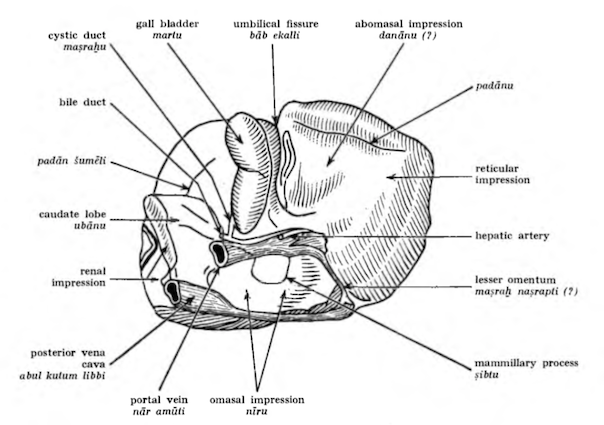The 'Path' (padānu)
The 'path' (padānu) appears in the liver models from Boghazköi as a marking on the ventral lobe of the liver perpendicular to the 'station,'[[110]] and is perhaps identifiable with the abomasal impression on the liver (cf. RIA 6 525, fig. l). It is not identical with neptû, a marking on the liver which usually appears in omen texts among protases dealing with the padānu, and in extispicy reports where one would expect the padānu to be in the canonical order of parts of the liver (i.e., following the 'station').[[111]]
One of the most common characteristics of the 'path,' especially in omen texts of the first millennium, is the existence of two or more such markings on the liver. The 'paths,' two or more, are placed in various combinations, and form a variety of designs, as the following examples from the omen collections illustrate:
Omens concerning two 'paths' are attested already in OB extispicy reports.[[112]] When two or more 'paths' are present, one may be shorter than the other(s).[[113]] Another characteristic of the 'path,' attested especially in the late texts, is its predilection to acquire a bifurcation (larû).[[114]] Finally, the 'path' is often said to be effaced (pašṭu), in whole or in part,[[115]] or curled (kapṣu/kuppuṣu).[[116]]
Aside from the 'path' itself, several other markings, such as the šubtu (logograms DAG, KI.TUŠ) and pušqu (logogram PAB.HAL),[[117]] are also attested in omen texts and extispicy reports. The exact relation of these markings to the 'path' is not entirely clear, but note, for example, the protasis "the 'path' reaches its 'seats,'" commonly attested in the Sargonid reports and queries,[[118]] and the references to 'seats' to the right and left of the 'path.'[[119]] The 'path' is also said to descend or fall towards towards the left 'seat' (JCS 21 229 M:22) or towards its 'narrow part.'[[120]] "Descending" toward its own and other parts of the liver[[121]] is therefore another characteristic of the 'path.'

FIG. 8. Sheep's liver, visceral surface. Drawing by R.D. Biggs after S. Sisson and others. RA 63 160..
An OB text dealing in part with the pušqu is YOS 10 20. See also Starr Rituals 32:44, 34:101, and the discussion ibid. p. 79.
110 For a discussion of the 'path' and its various writings, see Starr Rituals, p. 78f.
111 For neptû, see for example JCS 37 148:13 and 150:56 (both MB reports), ne-ep-tu-û i-na ZAG.GAR (preceded by KI.GUB TUKU); CT 20 23 K 4702:6, BE né-ep-tu-ú ina 15 GAR; CT 51 151 r.2f, BE né-ep-tu-ú ina 15/150 GAR-in, all other protases in this text: GÍR. However, the two are not identical. They are listed separately in JCS 37 135:36f (a MB extispicy report).
112 E.g., pa-da-nu ši-na pa-da-ani-mi-tim e-li pa-da-an šu-me-lim iz-zi-iz," there are 2 paths, 'the right 'path' stands över the left 'path'," JCS 11 101 no. 12:9ff.
113 "There are two paths, and the upper/lower one is short," CT 20 10:7ff, cf ibid. 16 K 6766 r.1 and passim. See also CT 20 25 K 11826:6, "there are three paths, and the middle one is short."
114 Cf. e.g. no. 3r.16 (a bifurcation on the right of the 'path') and 66 r.4 and 286:2 (two 'paths,' the right one having a bifurcation toward the left one). Note also CT 20 11 K 6393:11 and no. 20 r.14 (right and left 'path' with a bifurcation). For an OB example, see RA 67 (1973) 50:14f.
115 E.g., CT 20 11:23-26. This protasis, when said of the middle part of the 'path,' (cf. CT 20 14f), is a common protasis in the Sargonid queries and reports, see 14 s.1, 41 r.11, 43 r.14, 64 r.13, 168 r.4, etc.
116 This characteristic, not unique to the 'path,' is well attested from the OB period on, see e.g. JCS 21 222 F:4 (late OB report), JCS 37 146 no. 17:6 (MB report), and nos. 5 r.9, 285:4, 290:25, 292 r.2, and 306:3 of the present corpus.
117 The pušqu is occasionally attested in syllabic writing in late OB and MB reports, e.g. JCS 21 no.9:3 (OB) and YOS 10 2:4 (MB). Cf. also RA 41 50:4.
118 E.g., 229 r.6, 283:1, 337:1, cf. 316:5 and 323:10. This protasis is attested already in the OB extispicy reports, e.g. Babyl. 2 pl. 6:16, 3 pl. 9:5 and the MB report JCS 37 148:9.
119 See JCS 11 no.8:6, 21 220 C:2f and 222 G:3. For the ominous significance of these statements, see Starr Rituals, p. 112. On šubat imitti/šumēli, see also KAR 454 r.1ff.
120 Cf. CT 20 8:12f, "the 'paths are two and the right 'path descends toward the right pušqu, the left 'path descends toward the left pušqu," and query no. 290:12 "the 'path' has a bifurcation toward the right pušqu."
121 E.g., the 'gate of the palace,' CT 20 29 r.8. and ibid. 10:2f, BE GÍR ana 15/150 ma-qit.
Ivan Starr
Ivan Starr, 'The 'Path' (padānu)', Queries to the Sungod: Divination and Politics in Sargonid Assyria, SAA 4. Original publication: Helsinki, Helsinki University Press, 1990; online contents: SAAo/SAA04 Project, a sub-project of MOCCI, 2020 [http://oracc.org/saao/saa04/theliveranditsparts/thepath/]